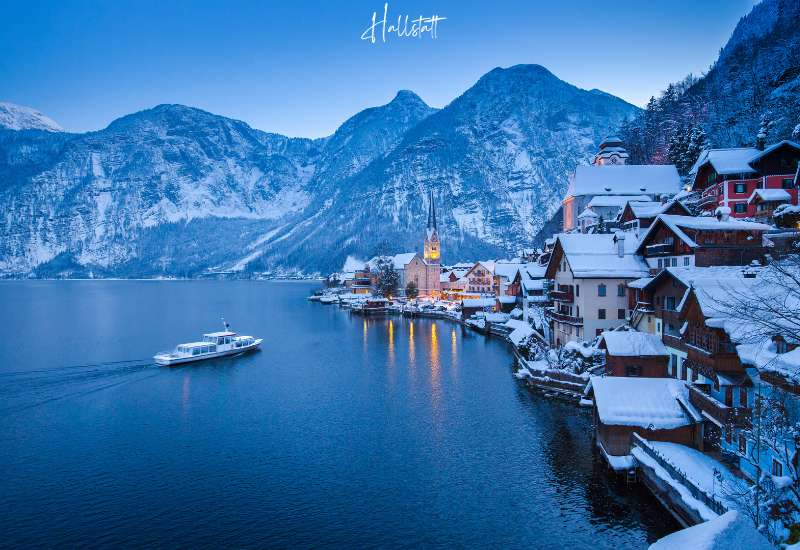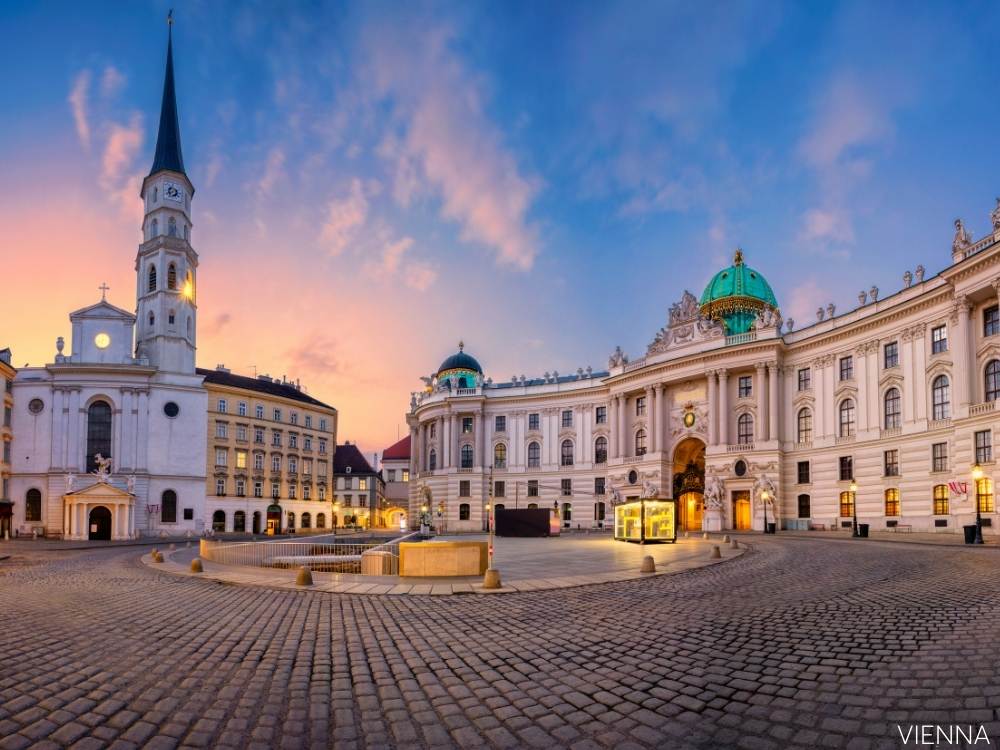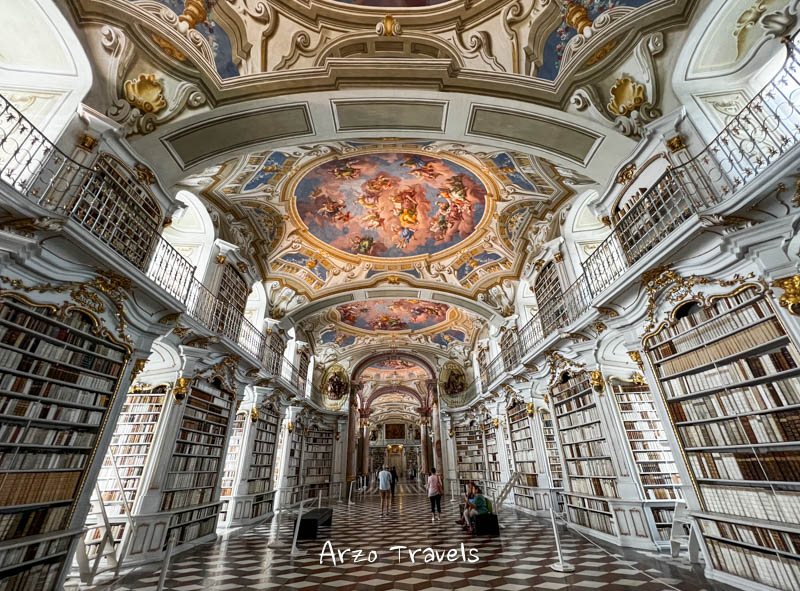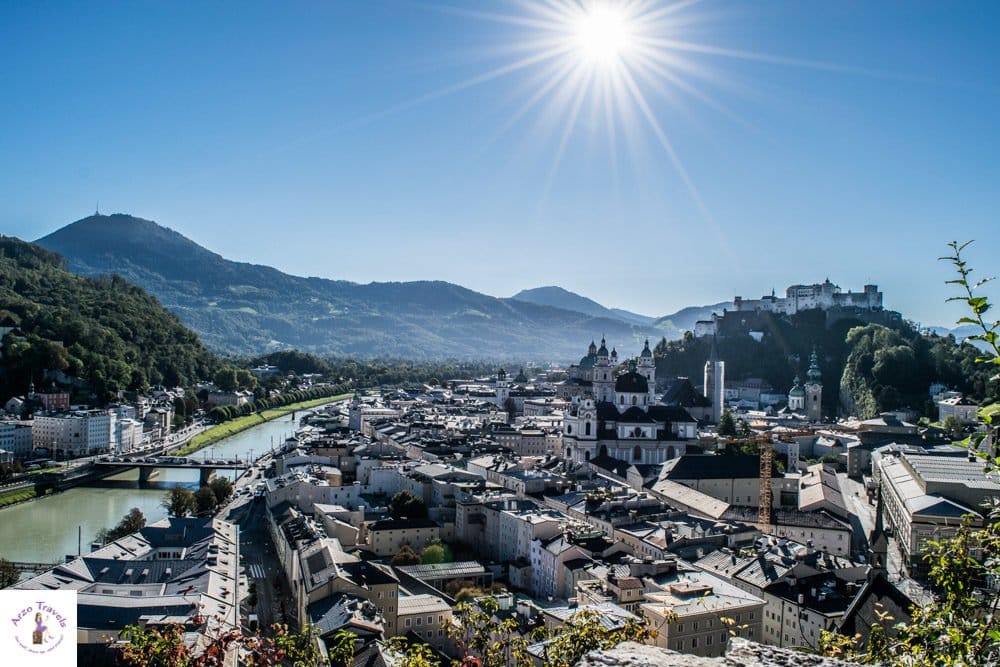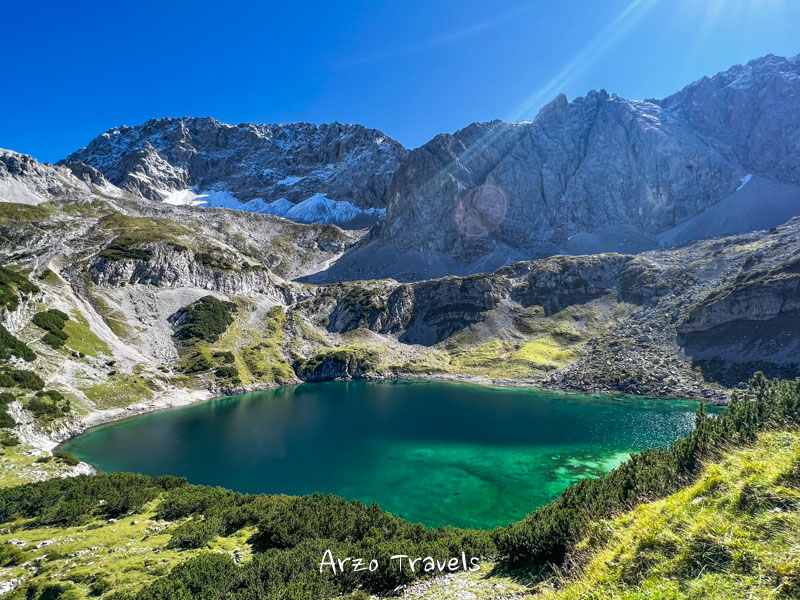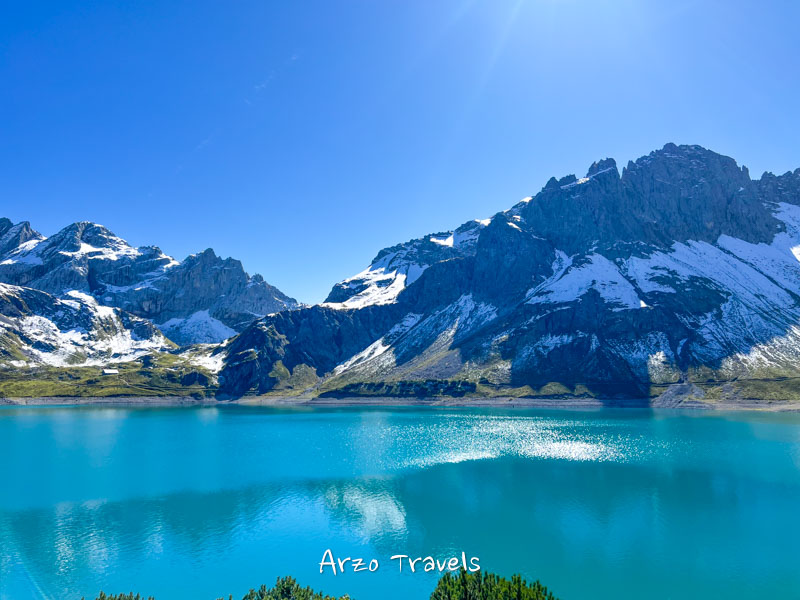Are you looking for tips on how to plan an amazing road trip in Austria? Then this post is for you! Here I share tips for an epic road trip itinerary plus many travel tips for exploring Austria by car.
DISCLAIMER: THIS POST MIGHT CONTAIN AFFILIATE LINKS. THIS MEANS I MIGHT EARN A SMALL COMMISSION WHEN YOU BUY A PRODUCT/SERVICE (AT NO EXTRA COST TO YOU). MORE ABOUT IT HERE.
TRAVEL TIPS FOR AN AUSTRIA ROAD TRIP
Here are a few tips for your road trip adventure.
TOLLS IN AUSTRIA
When we talk about paying for driving Austria´s roads, then you will (at least this is my recommendation) have to pay for a vignette sticker (which you stick to your window shield, or get electronically) and extra tolls for a few other roads.
VIGNETTE STICKER
A Vignette in Austria is a toll sticker required for vehicles on motorways and expressways. Whenever I road trip Austria, I normally get the 10-day Vignette Sticker, but I will introduce you to both:
- 10-Day Vignette Sticker: Valid for 10 consecutive days, this Vignette is suitable for short-term travelers or brief road trips in Austria. I normally purchase it at one of the gas stations near the border crossings. PRICE: Around 10 Euros.
- 2-Months Vignette Sticker: This option is ideal for extended road travel. Like the 10-day version, it’s available at border points, various gas stations, and other approved locations. PRICE: Around 30 Euros.
You can also buy your vignette online and explore Austria with your digital vignette.
TOLLS
Despite the toll sticker, unfortunately, there are more private roads and tunnels that will charge you an extra toll. Since I do not know your exact route, it is difficult to predict your exact amount for the tolls. I suggest calculating about 100 Euros in total for all tolls and the vignette sticker.
This includes the 40 €uro toll for the famous Grossglockner High Alpine Mountain Road.
PETROL STATIONS IN AUSTRIA
Austria has an extensive network of petrol stations. Most petrol stations are open 24/7.
The majority of petrol stations in Austria accept credit cards.
The petrol prices in Austria are generally reasonable (by Western European standards): Unleaded petrol and diesel are both about 1,60€ a liter.
RENTING A CAR IN AUSTRIA
When renting a car in Austria, consider the following tips to ensure a smooth and hassle-free experience:
Documentation: Have a valid driving license. If your license isn’t in English or German, you might want to get an International Driving Permit (IDP) to accompany your original license.
Driving Age: The minimum age to rent a car in Austria is usually 18, but most car rental companies impose a minimum age of 21 or even 25, especially for larger vehicles.
Rental Insurance: Check the insurance options offered by the rental company. Collision Damage Waiver (CDW) and theft protection are common but might come with high deductibles. Check if your travel or credit card insurance offers any coverage for rental cars.
Winter Equipment: Between November 1 and April 15, all vehicles must be equipped with winter tires in Austria. If you’re traveling during this period, ensure your rental car is equipped accordingly. Chains are also required in certain mountain areas.
Vignette (Toll Sticker): If you’re using Austria’s motorways and expressways, you’ll need a vignette. Some rental cars come with one already but always double-check. If your travel takes you to neighboring countries, you might need additional vignettes or toll payments.
Fuel Policy: Understand the fuel policy. Some companies provide a full tank and expect it to be returned full, while others might charge you for a full tank upfront and allow you to return it empty.
GPS & Navigation: Consider renting a GPS system or ensure your phone has local maps downloaded for offline use.
Inspect the Vehicle: Before leaving the rental lot, inspect the car for any existing damage, and make sure it’s documented on the rental agreement to avoid any disputes later.
Parking: In cities like Vienna, parking can be a challenge. Familiarize yourself with the local parking signs and regulations. Blue zones indicate short-term parking areas where you’ll need a parking ticket.
Local Driving Laws: Austrian roads are well-maintained, but understanding local traffic regulations is crucial. For instance, in Austria, you drive on the right side of the road, and you must always give way to buses and trams. Also, it’s mandatory to have headlights on during the day when driving outside city limits.
Drop-off Location: If you’re planning to drop off your car in a different location from where you picked it up, make sure to check if there are any additional fees.
Emergency Number: The general emergency number in Austria is 112. It’s good to have this handy in case of an emergency.
Language: While many Austrians speak English, especially in the service industry, it might be helpful to know a few basic German phrases or have a translation app to facilitate communication.
Lastly, always book in advance, especially during peak travel seasons, to ensure availability and better rates.
I normally drive in my car/van when I road trip countries like Switzerland or Austria. However, when I went to Albania last year, I rented my car via DiscoverCars, and it was a smooth and easy booking process.
CHECK OUT RENTAL PRICES FOR YOUR AUSTRIA ROAD TRIP HERE
BUDGET FOR YOUR AUSTRIA ROAD TRIP
How much an Austrian road trip will cost depends, of course, mostly on how long you will road trip, if you have to rent a car, what type of car you have, and how much you will drive.
I am not talking about accommodation, food, and activities, but here are some costs/prices.
RENTING A CAR COSTS: If you have to rent a car in Austria, you should budget between 30-60 euros for a day (for smaller and medium-sized cars). Plus, I highly suggest having full insurance and not only the basic one that comes with a rental car.
PETROL/DIESEL: Petrol/gas and diesel prices vary in Switzerland – you can expect to pay about 1,90 € on average for 1 liter of Diesel and 1,80 € for 1 liter of gas/petrol. With these high gas/diesel prices, it might make sense to rent a smaller car if possible.
TOLL/VIGNETTE: You might have to pay a vignette and tolls for Austria. If you have a rental car, the vignette might already be included, but tolls normally still have to be paid. I assume you will have to pay between 10-120 €.
PARKING: Parking is not cheap in Austria. You might find free parking at some tourist spots (especially and mostly for cable car stations outside the town/city center) or along the shores of the lakes, etc., but you can expect to pay around 1-2 € an hour for outdoor parking.
AUSTRIA ROAD TRIP ITINERARY
These are some of my all-time favorite places in Austria – some of the best places in Austria. However, considering everyone’s unique preferences and the unknown duration of your road trip, please tailor the itinerary accordingly.
VIENNA – A JEWEL IN EUROPE
1-3 DAYS
- Paid parking is available in many parts of the city, but often for a short amount of time. If you want to stay longer than a few hours, I recommend prior research or leave the car at your hotel and then use the great public transport in Vienna
Vienna, Austria’s capital, stands out as one of Europe’s most beautiful cities. The city is a living testament to epochs gone by while still pulsating with modern vibrancy. No Austria road trip would be complete without staying in Vienna for at least 1 day or one night.
Main Sights to See and Do:
- Schönbrunn Palace: Once the imperial summer residence, this Baroque palace is renowned for its beautifully landscaped gardens and opulent rooms.
- St. Stephen’s Cathedral (Stephansdom): An iconic Gothic masterpiece that dominates the Vienna skyline.
- Belvedere Palace: Houses one of Austria’s most valuable art collections, including Gustav Klimt’s “The Kiss”.
- Hofburg Imperial Palace: The former principal imperial palace; today it serves as the residence of the President of Austria.
- Vienna State Opera (Wiener Staatsoper): One of the leading opera houses in the world; catch a performance or take a guided tour.
- MuseumsQuartier: A lively area with a mix of art museums, courtyard cafes, and boutiques.
- Prater Park: Home to the famous Giant Ferris Wheel and numerous other attractions.
Oh, Vienna – it is not only a top spot in Austria to visit but one of the most beautiful places in Europe in my opinion.
READ MORE: 2 DAYS IN VIENNA ITINERARY
WHERE TO STAY IN VIENNA
- HOTEL SACHER: Find luxury at its best at Hotel Sacher near Hofburg. The hotel is rated the best in the city, and its central location is perfect if you want to limit driving around or use public transportation. ➡️ Find out more about the rates for staying in this hotel here.
- MERCURE VIENNA FIRST: One good medium-priced accommodation to stay in Vienna is Mercure Vienna First. It was the place I stayed at when I visited Vienna the last time. ➡️Find out more about that particular hotel by clicking here.
I also have a more detailed guide on the best accommodations in Vienna, which you can check out.
ABBEY ADMONT – A MAGNIFICENT LIBRARY AND MORE
0,5-1 DAY
- Free parking in front of the abbey is available.
Abbey Admont, tucked away in the scenic landscapes of Styria, is a magnificent embodiment of baroque art and architecture. When you visit, you’ll be drawn to the Admont Library, hailed as the world’s largest monastic library and often dubbed the “Eighth Wonder of the World.”
Marvel at the intricate ceiling frescoes, exquisitely carved wooden sculptures, and an invaluable collection of manuscripts. Bathed in natural light, the gold and white interiors craft a divine atmosphere that captivates.
Delve into the Abbey’s extensive museum complex, boasting modern art, natural history, and cherished artifacts. Wander through the tranquil church, a seamless fusion of Gothic and Baroque designs, and take a moment to relax in the verdant monastery gardens.
I admit that culture is not always my top priority when I travel, but this library was really one of the highlights, and I think you should visit it, too.
SALZBURG – AUSTRIA´S PRETTIEST CITY
1,5-2 DAYS
- Paid parking is available in many parts of the city but often for a short amount of time. If you want to stay longer than a few hours, I recommend prior research (or leave the car at your hotel and then use the great public transport in Salzburg).
Salzburg, the birthplace of Wolfgang Amadeus Mozart, seems to have been lifted straight from a fairy tale. With its breathtaking Alpine backdrop, Baroque spires, and the meandering Salzach River, Salzburg is undeniably one of Europe’s most picturesque cities.
Main Sights to See and Do:
- Hohensalzburg Fortress: Dominating the city’s skyline, this fortress offers panoramic views and a glimpse into medieval life.
- Mozart’s Birthplace (Mozart Geburtshaus): Visit the house where the legendary composer was born and learn about his early life.
- Mirabell Palace and Gardens: A stunning Baroque palace with meticulously manicured gardens, often linked with “The Sound of Music.”
- Salzburg Cathedral (Salzburger Dom): A 17th-century Baroque cathedral with a majestic interior.
- Hellbrunn Palace: Famous for its trick fountains, this Renaissance palace is a delight for both kids and adults.
- Getreidegasse: Salzburg’s historic shopping street, lined with medieval and Baroque buildings and wrought-iron guild signs.
- St. Peter’s Abbey: One of the oldest monasteries in the German-speaking world, with a beautiful cemetery and catacombs.
- The Sound of Music Tour: Follow in the footsteps of the Von Trapp family and visit iconic locations from the film.
Salzburg might be even prettier than pretty Vienna, so make sure to add it to your itinerary.
READ MORE: 2 DAYS IN SALZBURG ITINERARY
WHERE TO STAY IN SALZBURG
- HOTEL RADISSON BLU: If you want to stay in the old town and prefer a luxury hotel, then the Radisson Blu most likely is the perfect choice for you. ➡️ Check out rates for the hotel here.
- STAR INN PREMIUM SALZBURG: If you are looking for a good but more affordable hotel in the city center, then the Star Inn Premium Salzburg would be a good pick. ➡️ Check out rates for the hotel here.
- IBIS BUDGET AIRPORT SALZBURG: I normally opt for hotels in the city center; however, since I was driving my own car, I decided to stay outside the main city center. So, I ended up at Ibis Salzburg Airport. There was enough free parking, and I had to walk for about 7 minutes to the bus stop, which was perfect for me. ➡️ Check out the prices for the hotel here.
HALLSTATT: EUROPE’S PICTURESQUE LAKESIDE GEM
1 DAY
- Paid parking is available before you arrive in Hallstatt; you cannot drive your car all the way to the town center. Leave your car at the car park and then walk to the town center.
- If you have a hotel in the heart of Hallstatt that includes parking, you still have to park your car a bit outside the center.
The UNESCO World Heritage region of Hallstatt Dachstein Salzkammergut boasts a stunning fusion of natural beauty and cultural significance. Its pristine landscapes, historical salt mines, and the idyllic village of Hallstatt epitomize Central Europe’s timeless allure.
Nestled between the Dachstein Alps and the serene Hallstätter See, Hallstatt is often dubbed the “Pearl of Austria”.
Main Sights to See and Do:
- Hallstatt Salt Mines (Salzwelten): Venture into the world’s oldest known salt mines and discover the town’s ancient salt mining history.
- Hallstatt Skywalk “World Heritage View”: A viewing platform that offers breathtaking panoramic views of the town, lake, and surrounding mountains.
- Market Square: The heart of Hallstatt, lined with colorful historic buildings and the iconic Evangelical Parish church.
- Bone House (Beinhaus): A small chapel in the St. Michael’s Church cemetery that houses over 600 painted skulls, a unique local custom.
- Hallstätter See: The pristine lake offers opportunities for boat rides, allowing visitors to soak in the town’s beauty from the water.
- Hallstatt Museum: Chronicles the 7,000-year history of the region, from prehistoric times to the present.
I absolutely adore Hallstatt. Though I love places like Salzburg or the Alps more, it is still a must-see in my eyes.
READ MORE: 1 DAY IN HALLSTATT ITINERARY
GROSSGLOCKNER HIGH ALPINE ROAD
1 DAY
- A lot of free parking spots along the mountain pass.
The Grossglockner High Alpine Road stands as Austria’s loftiest paved mountain pass road. Linking Bruck in the Salzburg region to Heiligenblut in Carinthia, it passes through the Fuscher Törl at 2,428 meters above sea level and the Hochtor Pass at 2,504 meters above sea level. This road derives its name from the Grossglockner, the tallest peak in Austria.
The road, established in 1935, has seen numerous changes, becoming wider, safer, and more user-friendly. The road seamlessly integrates with its surroundings, providing a distinctive mountain experience, and offers 48 kilometers of driving.
Driving on this road comes with a cost – a toll of 40€ for a car.
I love driving mountain roads – I have driven my fair share (normally in Switzerland) and do think this is a great place to drive. However, the high price tag for just driving on one road is quite a bummer.
INNSBRUCK: THE ALPINE JEWEL OF AUSTRIA
1 DAY
- Paid parking is available, but as in many cities, it can be tricky to find parking spots. You can leave your car at the hotel and get around by public transportation –> but it is a small city where you can mostly walk to most sights.
Nestled amidst the soaring peaks of the Tyrolean Alps, Innsbruck is renowned for its rich history and iconic architecture and as a hub for winter sports, but it also makes a wonderful spot to spend a day strolling its charming narrow streets.
Main Sights to See and Do:
- Golden Roof (Goldenes Dachl): Located in the city center, this landmark is adorned with 2,657 fire-gilded copper tiles and offers a glimpse into Emperor Maximilian I’s reign.
- Nordkette Mountains: Accessible by the Nordkette Cable Car, this is a must-visit for panoramic city views and numerous hiking trails.
- Imperial Palace (Hofburg): A grand testimony to the Habsburg dynasty’s influence, it showcases opulent state apartments and historical exhibitions.
- Innsbruck Cathedral (Dom zu St. Jakob): An 18th-century Baroque masterpiece with impressive frescoes and a notable organ.
- Old Town (Altstadt): Wander through the historic heart of the city center, with its medieval houses, vibrant cafes, and bustling squares.
Innsbruck is a beautiful city with a gorgeous backdrop. Its proximity to the Austrian Alps makes it an even better place to visit.
DRACHENSEE & SEEBENSEE: STUNNING MOUNTAIN LAKES
1 DAY
- Paid parking in front of the cable car station
Drachensee Lake Seebensee
The Drachensee and the Seebensee – nestled amidst the Austrian Alps, or to be more precise in the Tyrolean Alps, are highlights for any nature lovers.
Embarking on a hike to these lakes was like stepping into a dream. The Drachensee, with its name translating to “Dragon Lake,” is a crystal-clear glacial lake sitting at an altitude of about 1,910 meters. Its deep blue waters, reflecting the surrounding peaks, make it seem as if dragons might indeed lurk in its depths.
Not far from Drachensee is the Seebensee, an equally enchanting alpine lake perched at around 1,657 meters above sea level. The panoramic views of the surrounding Zugspitze and Mieminger mountain ranges from this spot are simply breathtaking.
The hike to these lakes is easy to intermediate, making it perfect for a day out in the Alps.
This journey offers it all: pristine waters, majestic mountains, and a serene atmosphere. It was a day of pure alpine magic, reaffirming my belief that Austria holds some of the most gorgeous places on Earth.
Though it is not close to other main attractions in Austria (except Innsbruck), I cannot recommend this place and this hike enough. The beauty and tranquility of Drachensee and Seebensee are experiences that will stay with you long after you’ve left. It is actually as pretty as the Swiss lakes!
LÜNERSEE – THE PEARL OF THE ALPS
1 – 2 DAYS
- FREE PARKING IN FRONT OF THE CABLE CAR STATION
Nestled high in the Alps, a jewel tucked away in the Vorarlberg Region at an elevation of about 1,970 meters, the Lünersee is a shimmering expanse of turquoise that’s framed by majestic peaks. The lake’s pristine waters reflect the soaring mountains, creating a scene that’s almost surreal in its beauty.
Once I got up there by cable car, it was time to set off on a hike around the lake. The trail is a blend of easy to intermediate terrains, making it ideal for a day’s excursion in the Alps. Walking around the lake, you will be treated to different perspectives of the lake and its surroundings, each more breathtaking than the last.
The Lünersee, being one of the largest natural mountain lakes in the Eastern Alps, serves as both a serene escape and an adventure hub. Beyond the main trail, there are numerous hiking routes leading to higher vantage points and alpine huts.
If you ever journey to Austria’s alpine regions, do not miss this gem; it’s nature at its finest.
Getting there might be time-consuming – hidden in the remote Brandnertal Valley – yet it is an experience driving this mountain road. If you are into nature, I highly suggest staying 1 to 2 days in the gorgeous Brandnertal Valley near the Swiss border.
FINAL THOUGHTS OF AN ROAD TRIP IN AUSTRIA
I truly enjoy whenever I go on a road trip in Austria. The flexibility of journeying through Austria’s scenic routes provides me with an unmatched sense of freedom.
Each turn introduced me to postcard-worthy vistas, from majestic Alpine peaks to serene lakeside towns.
An Austria road trip allowed me to immerse myself in both the country’s historic charm and natural beauty at my own pace.
READ MORE

